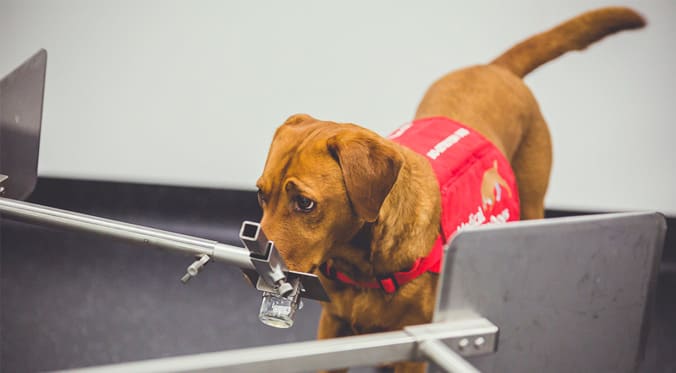A New Way to Detect Prostate Cancer…..Inspired by Man’s Best Friend

Dogs can serve as guides for people who are blind, support individuals with autism, and “smell” changes in blood sugar, warning a person with diabetes that they need to take action. (Dogs are now being trained to detect COVID-19!) In cancer, there have been many previous small and uncontrolled studies of dogs’ ability to detect several types, including melanoma, ovarian, bladder, and prostate cancer.
The PSA test for prostate cancer screening can miss some cancers AND signal the presence of non-aggressive cancers that can lead to overtreatment. We need to add better additional diagnostic tests.
Groundbreaking new research published today in the journal PLoS One validates that dogs can “sniff out” aggressive Gleason 9 prostate cancers. This information may someday be combined with other data sources to build a “machine nose” for prostate cancer detection.
A team of scientists from Medical Detection Dogs in the UK, the Prostate Cancer Foundation (PCF), Massachusetts Institute of Technology, and Johns Hopkins University performed a series of experiments. Their aim was to combine the strengths of three different methods – canine detection, analysis of odor molecules from urine, and analysis of urinary microbial organisms – to distinguish between cancer and non-cancer samples.
Under rigorous, controlled conditions, two specially-trained medical detection dogs were able to discriminate between prostate cancer and negative-control urine samples. (You can watch the video here.) The dogs correctly identified 71% of the samples from patients with Gleason 9 prostate cancer, and were 70-76% correct in identifying samples without cancer. The dogs could even distinguish prostate cancer vs other prostate diseases. Dogs have a remarkable ability to detect odors in very small amounts – they have 300 million olfactory receptors, compared with 6 million in humans, as well as other anatomic differences. Building on that, the specialized training allows them to effectively communicate what they’ve smelled.
In another set of experiments, researchers used an instrument to characterize the types and amounts of odor molecules (called “volatile organic compounds” or VOCs) emitted from urine samples. Analysis of the VOCs in urine showed differences between the cancer-positive vs negative samples. The team also looked at organisms in the urine samples (the “urinary microbiome”) from patients with and without Gleason 9 cancer. They found different types of bacteria in the cancerous vs benign urine samples, though the differences were not sufficient to make the urinary microbiome a useful prediction tool for prostate cancer on its own. Finally, the data from the urine VOC analysis was input into a computer program to “train” it to distinguish between cancer-positive samples and controls.
This pilot study provides compelling evidence that additional R&D is clearly warranted. This combination of three approaches may be used to inform the development of an “artificial nose” sensor that could eventually be a part of your smartphone, to detect potentially lethal prostate cancers much earlier than just a PSA test. More and larger cross-disciplinary, collaborative studies are needed. As this technology advances, the “nose” may eventually be scaled and adapted for other diseases, perhaps as an app on your smartphone.
Will dogs, or an app, replace the PSA test? No. But they could improve upon detection for thousands of patients, earlier in their disease. Most people don’t have a specially-trained, prostate-cancer-sniffing dog, so that is why an app to replicate the dog’s nose needs to be built. (This same approach has revolutionized bomb sniffing in airports: machines now sniff luggage for explosives, instead of dogs.) So, PSA screening remains the gold standard for prostate cancer screening. Start talking to your doctor about screening at age 45 (age 40 if you’re Black, have a strong family history of cancer, or have known cancer risk gene mutations in your family). PSA levels are also a key tool for monitoring prostate cancer after diagnosis.
What this work does highlight immediately for men with prostate cancer is the value of contributing tissue and urine samples to biobanks. It’s only with contributions of samples that this research is even possible. If you are asked whether your biopsy tissue or other material can be used for research, get the facts, ask questions, and please consider how this may help you or future patients.
PCF is proud to have funded this truly creative, out-of-the-box research as a collaborator all along the way. For example, the team’s analysis of the odor molecules from the urine was unique: compared to previous studies, it was performed under conditions that better mimic the complex way scent works in the “real world’ vs in a lab. Solving difficult problems – such as the need for an accurate prostate cancer screening tool – demands innovative thinking from across scientific disciplines, in this case encompassing oncology, organic chemistry, microbiology, animal behavior, physics, and computer science.
For more information, sign up for updates at: pcf.org/dogs









